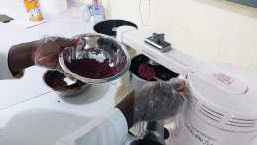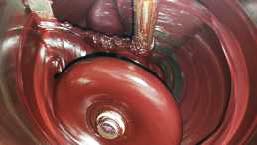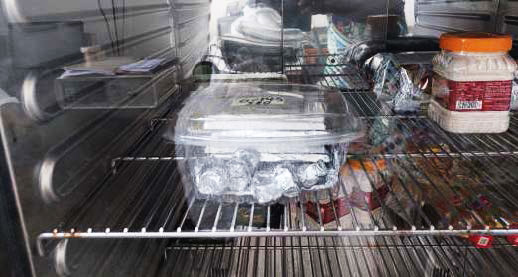
BEETROOT DARK CHOCOLATE
ProjectResearch Program
Fruits & Vegetables
Duration
30 Months
Funding Source
CSIR
Collaborating Institutions
CSIR
Project Acronym
BEETROOT DARK CHOCOLATE
PROCESS DEVELOPMENT AND PRODUCT CHARACTERISTICS OF BEETROOT DARK CHOCOLATE USING THE MELANGER IN AN ALTERNATIVE CHOCOLATE PRODUCTION TECHNIQUE
The main goal of this project is to develop beetroot dark chocolate using the melanger as an alternative chocolate production technique and study the effect of beetroot powder concentration and processing time on the physicochemical, nutritional, bioactive compounds compositions, antioxidant capacity, particle size distribution, hardness, microbial safety, sensory profile (mouthfeel, aroma, taste), consumer acceptability and shelf life of the product.
Introduction
Dark chocolates are semisolid suspensions of fine solid particles from sugar and cocoa in a continuous fat phase, mainly cocoa butter. The quality characteristics of dark chocolates are influenced by ingredient composition and processing methods and must be controlled to obtain high-quality chocolate. There is a dynamic change in the chocolate industry with a drive towards high cocoa content in chocolates due to the high polyphenol content in cocoa beans which has been found to have beneficial effects on human health. However, the high cost of cocoa beans on the international markets significantly adds to the cost of chocolates with high cocoa content. There is a need to incorporate a food ingredient into dark
chocolates that are economical, rich in nutrients and has health-promoting properties. Beetroot (Beta vulgaris) is receiving increased recognition as a health-promoting food due to the presence of essential components such as vitamins, minerals, phenolics, carotenoids, nitrate and betalains and provides the opportunity for the development of functional foods. Despite the high nutritive and medicinal value of beetroot, it is under-utilized in Ghana, and
consumed only as juices and smoothies. There is also no information on the use of beetroot in dark chocolate manufacture. Incorporating beetroot in dark chocolates will improve the health-promoting properties of dark chocolates and contribute to the good health and wellbeing of consumers. This should also contribute to diversifying its utilization and reducing post-harvest losses.
Conventional chocolate manufacture consists of the following processing steps: mixing,refining, conching and tempering. These steps are carried out separately, requiring equipment with huge investment costs, operational space and the use of skilled personnel. The use of the alternative technique for chocolate production is thus, gaining attention
mainly due to the lower investment cost, maintenance and multi-functionality of thecequipment. The melanger is one of such piece of equipment found to have great potential incalternative small-scale chocolate manufacture. Studies on the use of the melanger for chocolate production have however, focused mainly on particle size reduction during refining and conching. The extent to which mixing, refining and conching could be carried out simultaneously in the melanger and how this influences the quality characteristics of dark chocolates remains unknown. With a national unemployment rate of 4.51% in 2020, a more cost-effective technique for chocolate production will provide decent employment and economic growth, especially for women and youth chocolate processors and retailers, who dominant small-scale chocolate value chain in Ghana, and contribute to eradicating poverty. The main goal of this project is to develop beetroot dark chocolate using the melanger as an alternative chocolate production technique and study the effect of beetroot powder concentration and processing time on the physicochemical, nutritional, bioactive compounds compositions, antioxidant capacity, particle size distribution, hardness, microbial safety, sensory profile (mouthfeel, aroma, taste), consumer acceptability and shelf life of the product.
Key Activities and Achievements:
Production of beetroot powder
Beetroot powder was produced from fresh beetroots. Fresh beetroots were sorted, washed, and peeled. The peeled beetroots were sliced (1 mm thick) and dried in a mechanical dryer (ZF100 series hot air circulation cabinet, Jinan Keysong Co. Ltd., China) at 60oC for 7 hr. The dried beetroots were then milled using a Panasonic super mixer grinder (MX-AC220, Panasonic Appliances, India) and sieved by passing through a 60-mesh sieve (250 μm). The beetroot powder produced was analyzed for physicochemical, nutritional composition, bioactive compound composition, antioxidant capacity, and microbiological safety
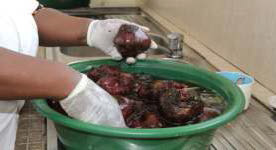
Washing of the freshly harvested beetroots
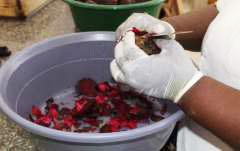
Peeling of the washed beetroots
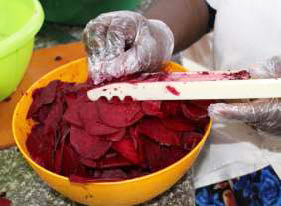
Slicing of the peeled beetroots

Arranging the sliced beetroot on trays
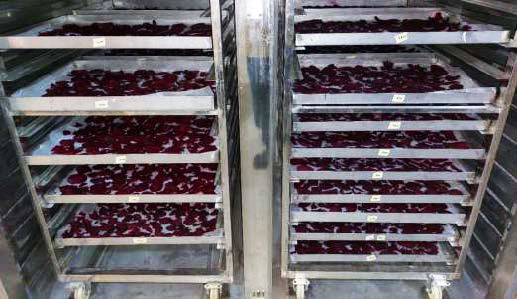
Beetroots arranged on trolleys and placed in the mechanical dryer
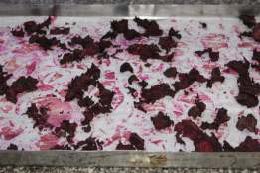
Dried beetroots after 7 hr of drying in the dryer at 60oC

Milling of the dried beetroots into powder using a super mixer grinder
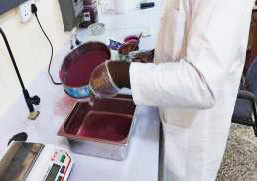
Sieving the milled beetroot powder through a 60-mesh sieve (250 μm)

Beetroot powder
Project Team






More Projects
Let's Talk!
Want to Do Business With Us? Connect with us and let's set the ball rolling. Our experienced professionals are eager to help your business thrive.

